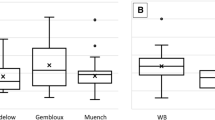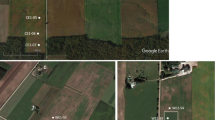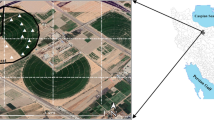Abstract
This study proposes a new method for inverting radiative transfer models to retrieve canopy biophysical parameters using remote sensing imagery. The inversion procedure is improved with respect to standard inversion, and achieves simultaneous inversion of leaf area index (LAI), soil reflectance (ρsoil), chlorophyll content (Ca+b) and average leaf angle (ALA). In this approach, LAI is used to constrain modelling conditions during the inversion process, providing information about the phenological state of each plot under study. Due to the small area of the vegetation plots used for the inversion procedure and in order to avoid redundant information and improve computation efficiency, existing plot segmentation was used. All retrieved biophysical parameters, except LAI, were assumed to be invariant within each plot. The proposed methodology, based on the combination of PROSPECT and SAILH models, was tested over 16 cereal fields and 51 plots, on two dates, which were chosen to ensure crop assessment at different phenological stages. Plots were selected to provide a wide range of LAI between 0 and 6. Field measurements of LAI, ALA and Ca+b were conducted and used as ground truth for validation of the proposed model-inversion methodology. The approach was applied to very high spatial resolution remote sensing data from the QuickBird 2 satellite. The inversion procedure was successfully applied to the imagery and retrieved LAI with R 2 = 0.83 and RMSE = 0.63 when compared to LAI2000 ground measurements. Separate inversions for barley and wheat yielded R 2 = 0.89 (RMSE = 0.64) and R 2 = 0.56 (RMSE = 0.61), respectively.








Similar content being viewed by others
References
Allen, W. A., Gausman, H. W., Richardson, A. J., & Thomas, J. R. (1969). Interaction of isotropic light with a compact leaf. Journal of the Optical Society of America, 59, 1376–1379.
Allen, W. A., Gayle, T. V., & Richardson, A. J. (1970). Plant-canopy irradiance specified by the Duntley equations. Journal of the Optical Society of America, 60, 372–376.
Aparicio, N., Villegas, D., Casadesus, J., Araus, J., & Royo, C. (2000). Spectral vegetation indices as nondestructive tools for determining durum wheat yield. Agronomy Journal, 92, 83–91.
Atzberger, C. (2004). Object-based retrieval of biophysical canopy variables using artificial neural nets and radiative transfer models. Remote Sensing of Environment, 93, 53–67.
Bacour, C., Jacquemoud, S., Leroy, M., Hautecoeur, O., Weiss, M., Prévot, L., et al. (2002). Reliability of the estimation of vegetation characteristics by inversion of three canopy reflectance models on airborne POLDER data. Agronomie, 22, 555–565.
Bennouna, Y. S., Cachorro, V. E., Torres, B., Toledano, C., Berjón, A., De Frutos, A. M., et al. (2013). Atmospheric turbidity determined by the annual cycle of the aerosol optical depth over north-center Spain from ground (AERONET) and satellite (MODIS). Atmospheric Environment, 67, 352–364.
Berjón, A. (2007). Determinación de parámetros biofísicos de la cubierta vegetal mediante inversión de modelos de transferencia radiativa. Ph.D. thesis, University of Valladolid.
Berjón, A. J., Cachorro, V. E., Zarco-Tejada, P. J., Frutos, A. M., & Toledano, C. (2006). Vegetation spectral reflectance inversion considering the temporal variation of biophysical parameters. In J. A. Sobrino (Ed.), Second recent advances in quantitative remote sensing (pp. 620–625). Valencia: Universitat de València.
Bunnik, N. J. J. (1978). Spectral reflectance and transmittance of single leaves. In H. Veenman & B. U. Zonen (Eds.), The multispectral reflectance of shortwave radiation by agricultural crops in relation with their morphological and optical properties (pp. 10–22). Veenman: Wageningen.
Cachorro, V. E., Berjón, A., Vergaz, R., & De Frutos, A. M. (2001). Creación de una base de datos espectroradiometricos de la reflectancia de cultivos de secano. In J. I. Rosell & J. A. Martinez-Casasnovas (Eds.), Teledetección, Medio Ambiente y Cambio Global. Proceedings of the IX Congreso Nacional de Teledetección (pp. 41–44). Lleida: Universitat de Lleida.
Cachorro, V. E., Duran, P., De Frutos, A. M., Vergaz, R., & Hernández, S. (1997). Modelización de la transferencia radiativa en la atmósfera. Comparación con datos experimentales a nivel de suelo y determinación de la reflectancia de la atmósfera. In C. Hernandez & J. E. Arias (Eds.), Teledetección Aplicada a la Géstion de Recursos Naturales y Medio Litoral Marino (pp. 42–45). Santiago de Compostela: Asociación Española de Teledetección.
Cachorro, V. E., Vergaz, R., & De Frutos, A. M. (2000). A model for atmospheric correction of DAIS hyperspectral imager sensor based on experimental measurements. In J. L. Casanova (Ed.), Remote sensing in the 21st century: Economic and environmental applications (pp. 541–548). Rotterdam: Balkema.
Campbell, G. S. (1986). Extinction coefficients for radiation in plant canopies calculated using an ellipsoidal inclination angle distribution. Agricultural and Forest Meteorology, 36, 317–321.
Campbell, G. S. (1990). Derivation of an angle density function for canopies with ellipsoidal leaf angle distributions. Agricultural and Forest Meteorology, 49, 173–176.
Carlson, T. N., & Ripley, D. A. (1990). On the relation between NDVI, fractional vegetation cover, and leaf area index. Remote Sensing of Environment, 62, 241–252.
Combal, B., Baret, F., Weiss, M., Trubuil, A., Macé, D., Pragnère, A., et al. (2002). Retrieval of canopy biophysical variables from bidirectional reflectance using prior information to solve the ill-posed inverse problem. Remote Sensing of Environment, 84, 1–15.
Darvishzadeh, R., Skidmore, A., Schlerf, M., & Atzberger, C. (2008). Inversion of radiative transfer model for estimating LAI and chlorophyll in a heterogeneous grassland. Remote Sensing of Environment, 112, 2592–2604.
Feret, J.-B., François, C., Asner, G. P., Gitelson, A. A., Martin, R. R., Bidel, I. P. R., et al. (2008). PROSPECT-4 and 5: Advances in the leaf optical properties model separating photosynthetic pigments. Remote Sensing of Environment, 112, 3030–3043.
Fernández, N., Paruelo, J., & Delibes, M. (2010). Ecosystem functioning in protected and altered Mediterranean environments: A remote sensing classification in Doñana, Spain. Remote Sensing of Environment, 114, 211–220.
Gausman, H. W., Allen, W. A., Cardenas, R., & Richardson, A. J. (1970). Relation of light reflectance to histological and physical evaluation of cotton leaf maturity. Applied Optics, 9, 545–552.
Goel, N. S. (1988). Models of vegetation canopy reflectance and their use in estimation of biophysical parameters from reflectance data. Remote Sensing Reviews, 4, 1–222.
Goel, N. S., & Strebel, D. E. (1983). Inversion of vegetation canopy reflectance models for estimating agronomic variables. I. Problem definition and initial results using the Suits model. Remote Sensing of Environment, 13, 487–507.
Green, E. P., Mumby, P. J., Edwards, A. J., & Clark, C. D. (2000). Remote sensing handbook for tropical coastal management. Paris: UNESCO.
Gueymard, C. (2004). The sun’s total and spectral irradiance for solar energy applications and solar radiation models. Solar Energy, 76, 423–453.
Gutman, G. G. (1991). Vegetation indices from AVHRR: An update and future prospects. Remote Sensing of Environment, 35, 121–136.
Haboudane, D., Miller, J. R., Tremblay, R., Zarco-Tejada, P. J., & Dextraze, L. (2002). Integrated narrow-band vegetation indices for predicting chlorophyll content for application to precision agriculture. Remote Sensing of Environment, 81, 416–426.
Houborg, R., Soegaard, H., & Boegh, E. (2007). Combining vegetation index and model inversion methods for the extraction of key vegetation biophysical parameters using Terra and Aqua MODIS reflectance data. Remote Sensing of Environment, 106, 39–58.
Jacquemoud, S., & Baret, F. (1990). PROSPECT: A model of leaf optical properties spectra. Remote Sensing of Environment, 34, 75–91.
Jacquemoud, S., Baret, F., Andrieu, B., Danson, F. M., & Jaggard, K. (1995). Extraction of vegetation biophysical parameters by inversion of the PROSPECT + SAIL models on sugar beet canopy reflectance data. Application to TM and AVIRIS sensors. Remote Sensing of Environment, 52, 163–172.
Jacquemoud, S., Verhoef, W., Baret, F., Bacour, C., Zarco-Tejada, P. J., Asner, G. P., et al. (2009). PROSPECT + SAIL models: A review of use for vegetation characterization. Remote Sensing of Environment, 113, S56–S66.
Kaufman, Y. J., Tanré, D., & Boucher, O. (2002). A satellite view of aerosols in the climate system. Nature, 419, 215–223.
King, M. D., Kaufman, Y. J., Tanré, D., & Nakajima, T. (1999). Remote sensing of atmospheric aerosols from space: Past, present and future. Bulletin of the American Meteorological Society, 80, 2229–2259.
Kuusk, A. (1985). The hot spot effect of a uniform vegetative cover. Soviet Journal of Remote Sensing, 3, 645–658.
Kuusk, A. (1995). A Markov chain model of canopy reflectance. Agricultural and Forest Meteorology, 76, 221–236.
Lauvernet, C., Baret, F., Hascoët, L., Buis, S., & Le Dimet, F.-X. (2008). Multitemporal patch ensemble inversion of couplet surface-atmosphere radiative transfer for and surface characterization. Remote Sensing of Environment, 112, 851–862.
Liang, S. (2004). Quantitative remote sensing of land surfaces. Hoboken: Wiley.
Liang, S. (2008). Advances in land remote sensing: System, modelling, inversion and application. New York: Springer.
Liedtke, J. (2002). QuickBird-2 System Description and product overview. JACIE Workshop. Washington, DC. http://calval.cr.usgs.gov/wordpress/wp-content/uploads/16Liedtk.pdf. Accessed 16 April 2013.
Lu, L., Li, X., Ma, M., Che, G., Huang, T., Bogaert, C. L., et al. (2004). Investigating relationship between Landsat ETM + data and LAI in a semi-arid grassland of Northwest China. In IGARSS 2004—2004 IEEE International Geoscience and Remote Sensing Symposium Proceedings (pp. 3622–3625). Piscataway: IEEE.
Migdall, S., Bach, H., Bobert, J., Wehrhan, M., & Mauser, W. (2009). Inversion of a canopy reflectance model using hyperspectral imagery for monitoring wheat growth and estimating yield. Precision Agriculture, 10, 508–524.
Morisette, J. T., Baret, F., Privette, J. L., Myneni, R. B., Nickeson, J. E., Garrigues, S., et al. (2006). Validation of global moderate-resolution LAI products: A framework proposed within the CEOS land product validation subgroup. IEEE Transactions on Geoscience and Remote Sensing, 44, 1804–1817.
Nelder, J. A., & Mead, R. (1965). A simplex method for function minimization. Computer Journal, 7, 308–313.
Richardson, A. J., Wiegand, C. L., Wanjura, D. F., Dusek, D., & Steiner, J. L. (1992). Multisite analyses of spectral-biophysical data for sorghum. Remote Sensing of Environment, 41, 71–82.
Saltelli, A. (2002). Sensitivity analysis for importance assessment. Risk Analysis, 22, 579–590.
Saltelli, A., Tarantola, S., & Chan, K. P. S. (1999). A quantitative model-independent method for global sensitivity analysis of model output. Technometrics, 41, 39–56.
Steven, M. D., Malthus, T. J., Baret, F., Xu, H., & Chopping, M. J. (2003). Intercalibration of vegetation indices from different sensor systems. Remote Sensing of Environment, 88, 412–422.
Suits, G. H. (1972). The calculation of the directional reflectance of a vegetative canopy. Remote Sensing of Environment, 2, 117–125.
Turner, D. P., Cohen, W. B., Kennedy, R. E., Fassnacht, K. S., & Briggs, J. M. (1999). Relationships between leaf area index and Landsat TM spectral vegetation indices across three temperate zone sites. Remote Sensing of Environment, 70, 52–68.
Verhoef, W. (1984). Light scattering by leaf layers with application to canopy reflectance modelling: The SAIL model. Remote Sensing of Environment, 16, 25–141.
Verhoef, W., & Bach, H. (2007). Coupled soil-leaf-canopy and atmosphere radiative transfer modelling to simulate hyperspectral multi-angular surface reflectance and TOA radiance data. Remote Sensing of Environment, 109, 166–182.
Vermote, E. F., Tanré, D., Deuzé, J. L., Herman, M., & Mocrette, J. J. (1997). Second simulation of the satellite signal in the solar spectrum, 6S: An overview. IEEE Transactions on Geoscience and Remote Sensing, 35, 675–686.
Vile, D., Garnier, E., Shipley, B., Laurent, G., Navas, M. L., Roumet, C., et al. (2005). Specific leaf area and dry matter content estimate thickness in laminar leaves. Annals of Botany, 96, 1129–1136.
Wang, Y. P., & Jarvis, P. G. (1988). Mean leaf angles for the ellipsoidal inclination angle distribution. Agricultural and Forest Meteorology, 43, 319–321.
Wellburn, A. R. (1994). The spectral determination of chlorophylls a and b, as well as total carotenoids using various solvents with spectrophotometers of different resolutions. Journal of Plant Physiology, 144, 307–313.
Zarco-Tejada, P. J., Berjón, A. J., Lopez, R., Miller, J. R., Martin, P., Cachorro, V. E., et al. (2005). Assessing vineyard condition with hyperspectral indices: Leaf and canopy reflectance simulation in a row structured discontinuous canopy. Remote Sensing of Environment, 99, 271–287.
Zarco-Tejada, P. J., Miller, J. R., Morales, A., Berjón, A., & Agüera, J. (2004). Hyperspectral indices and model simulation for chlorophyll estimation in open-canopy tree crops. Remote Sensing of Environment, 90, 463–476.
Zarco-Tejada, P. J., Miller, J. R., Noland, T. L., Mohammed, G. H., & Sampson, P. H. (2001). Scaling-up and model inversion methods with narrowband optical indices for chlorophyll content estimation in closed forest canopies with hyperspectral data. IEEE Transactions on Geoscience and Remote Sensing, 39, 1491–1507.
Zhangshi, Y., & Williams, T. H. L. (1997). Obtaining spatial and temporal vegetation data from Landsat MSS and AVHRR/NOAA satellite images for a hydrological model. Photogrammetric Engineering and Remote Sensing, 63, 69–77.
Acknowledgments
The author gratefully acknowledges the extensive help provided by Dr. Richard Santer (Maison de la Recherche en Environnement Naturel, Université Cote d’Opale, France) on atmospheric correction. Financial support was provided by project GR-220 of the Government of the Autonomous Community of “Junta de Castilla y León” and now by projects AGL2009-13105, CGL2011-23413 of the Spanish “Ministerio de Educación y Ciencia”. Thanks to AERONET and PHOTON teams for provided atmospheric parameters, and also to Department of Agricultural Engineering of E. T. S. of Agriculture Engineering of Palencia at the University of Valladolid for their help.
Author information
Authors and Affiliations
Corresponding author
Rights and permissions
About this article
Cite this article
Berjón, A.J., Cachorro, V.E., Zarco-Tejada, P.J. et al. Retrieval of biophysical vegetation parameters using simultaneous inversion of high resolution remote sensing imagery constrained by a vegetation index. Precision Agric 14, 541–557 (2013). https://doi.org/10.1007/s11119-013-9315-8
Published:
Issue Date:
DOI: https://doi.org/10.1007/s11119-013-9315-8




